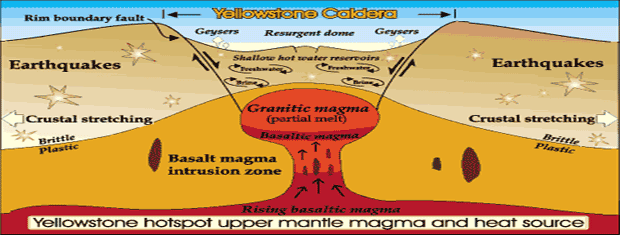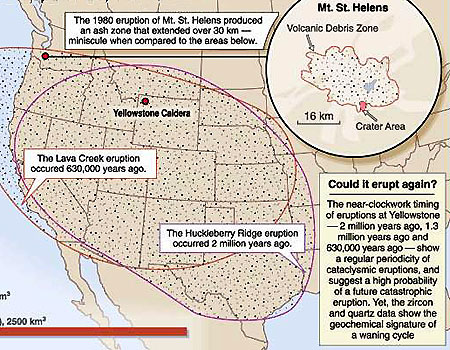Most people understand that Yellowstone is sitting on top of a super volcano. The shifting earth and hot spots are nothing new. But the scientist now say that although this is nothing new, it's just that they have never seen it so severe.
Literally turning asphalt to soup. This is something to keep an eye on, but don't panic and don't change your vacation plans, you may get to see something few people have ever seen before.
Photo Courtesy Steve Quayle
I am including four videos to help you understand just what Yellowstone is and what scientists have been watching for Decades.
In the first video, Daboo0077 weighs in on the current situation in Yellowstone today. The second video is a documentary on Yellowstone, it's history, and what to expect from Yellowstone in the future. Very educational.
The second video is from RT, describing the current situation in the park today. With more roads melting and gravel turning to oatmeal.
The third video is a documentary on Yellowstones history and what we can expect in the future from this supervolcano.
The second video is from RT, describing the current situation in the park today. With more roads melting and gravel turning to oatmeal.
The third video is a documentary on Yellowstones history and what we can expect in the future from this supervolcano.
The fourth video is How to survive a Yellowstone eruption. For preppers living in the Yellowstone area, this is a must see. Get the latest changes in Yellowstone condition as they happen.
The access road to the Old Faithful geyser in Yellowstone National Park
is being closed by park rangers because a supervolcano beneath the park
is literally melting the roadway.
Update: The only road being closed in Yellowstone is Fire Hole Lake Road. Upon further investigation, Steve Quayle who is at Yellowstone every week doing photography, clarified this information Old Faithful geyser is NOT being closed. RT's Manila Chan's statement was wrong!
Photo Courtesy Of Steve Quayle
Officials are prohibiting visitors from driving or stepping onto the asphalt, as what looks a solid surface can collapse and leave the unsuspecting guests stranded in a pool of hot water. RT's Manila Chan takes a look at the frightening scene in Yellowstone.
Update: The only road being closed in Yellowstone is Fire Hole Lake Road. Upon further investigation, Steve Quayle who is at Yellowstone every week doing photography, clarified this information Old Faithful geyser is NOT being closed. RT's Manila Chan's statement was wrong!
Photo Courtesy Of Steve Quayle
Officials are prohibiting visitors from driving or stepping onto the asphalt, as what looks a solid surface can collapse and leave the unsuspecting guests stranded in a pool of hot water. RT's Manila Chan takes a look at the frightening scene in Yellowstone.
Yellowstone National Park lies on top of a magma chamber that is 35-miles wide, waiting to erupt.
The
Yellowstone Caldera is the volcanic caldera and supervolcano located in
Yellowstone National Park in the United States, sometimes referred to
as the Yellowstone Supervolcano. The caldera is located in the northwest
corner of Wyoming, in which the vast majority of the park is contained.
The major features of the caldera measure about 34 by 45 miles (55 by
72 km).
The caldera formed during the last of three supereruptions over
the past 2.1 million years. First came the Huckleberry Ridge eruption
2.1 million years ago, which created the Island Park Caldera and the
Huckleberry Ridge Tuff. Next came the Mesa Falls eruption 1.3 million
years ago, which created the Henry's Fork Caldera and the Mesa Falls
Tuff. Finally came the Lava Creek eruption 640,000 years ago, which
created the Yellowstone Caldera and the Lava Creek Tuff.


The last
full-scale eruption of the Yellowstone Supervolcano, the Lava Creek
eruption which happened nearly 640,000 years ago, ejected approximately
240 cubic miles (1,000 km3) of rock, dust and volcanic ash into the sky.
Geologists
are closely monitoring the rise and fall of the Yellowstone Plateau,
which measures on average 0.6 inches (1.5 cm) yearly, as an indication
of changes in magma chamber pressure.


The upward movement of the
Yellowstone caldera floor between 2004 and 2008 — almost 3 inches (7.6
cm) each year — was more than three times greater than ever observed
since such measurements began in 1923. From mid-summer 2004 through
mid-summer 2008, the land surface within the caldera moved upward as
much as 8 inches (20 cm) at the White Lake GPS station. By the end of
2009, the uplift had slowed significantly and appeared to have stopped.
In January 2010, the USGS stated that "uplift of the Yellowstone Caldera
has slowed significantly" and that uplift continues but at a slower
pace.
The U.S. Geological Survey, University of Utah and National Park
Service scientists with the Yellowstone Volcano Observatory maintain
that they "see no evidence that another such cataclysmic eruption will
occur at Yellowstone in the foreseeable future. Recurrence intervals of
these events are neither regular nor predictable."


This conclusion was
reiterated in December 2013 in the aftermath of the publication of a
study by University of Utah scientists finding that the "size of the
magma body beneath Yellowstone is significantly larger than had been
thought." The Yellowstone Volcano Observatory issued a statement on its
website stating,
" Although fascinating, the new findings do not
imply increased geologic hazards at Yellowstone, and certainly do not
increase the chances of a 'supereruption' in the near future. Contrary
to some media reports, Yellowstone is not 'overdue' for a supereruption.
"
Other media reports were more hyperbolic in their coverage.
A
study published in GSA Today identified three fault zones that future
eruptions are most likely to be centered on. Two of those areas are
associated with lava flows aged 174,000--70,000 years, and the third
area is a focus of present-day seismicity.
In this video Tom Lupshu talks about upcoming talks and videos about Yellowstone
Supervolcano and the possible scenarios that could take place before and
after an Eruption. This one event will change the world as we know it
forever. Let's hope it never happens in our life time. But if it does, I
plan to Survive, How about you?


Stay At The Ready...
Join Us At Bunker Report On Facebook





No comments:
Post a Comment